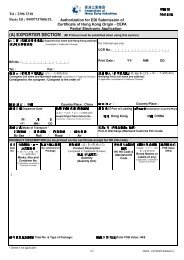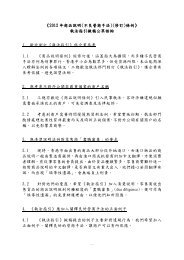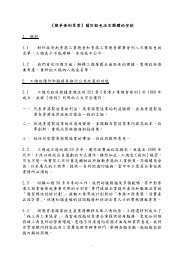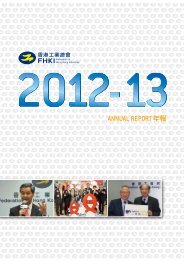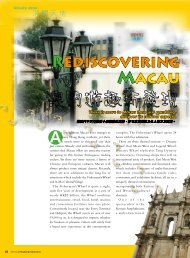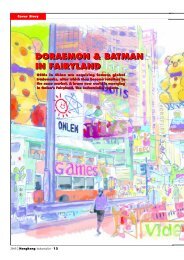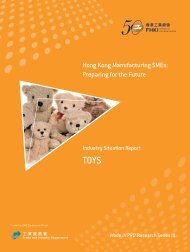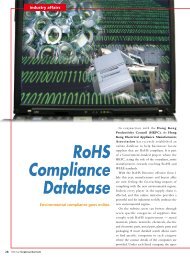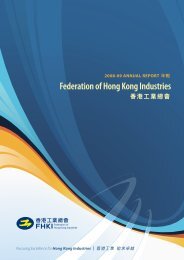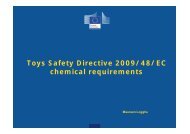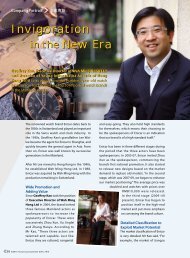Hong Kong Manufacturing SMEs: Preparing for the Future
Hong Kong Manufacturing SMEs: Preparing for the Future
Hong Kong Manufacturing SMEs: Preparing for the Future
- No tags were found...
You also want an ePaper? Increase the reach of your titles
YUMPU automatically turns print PDFs into web optimized ePapers that Google loves.
11Exhibit 6.Exhibit 7.<strong>Hong</strong> <strong>Kong</strong>’s Trade(HK$ billion)Guangdong’s Trade(US$ billion)350ImportsRe-exports45Exports300Domestic exportsTotal exports40Imports352503020025150201001510505001/20053/20055/20057/20059/200511/20051/20063/20065/20067/20069/200611/20061/20073/20075/20077/20079/200711/20071/20083/20085/20087/20089/200811/20081/20093/20095/20097/20099/200911/20091/20103/20105/20077/20079/200711/20071/20083/20085/20087/20089/200811/20081/20093/20095/20097/20099/200911/20091/20103/2010Source : <strong>Hong</strong> <strong>Kong</strong> Census and Statistics DepartmentSource : Guangdong CustomsThe onset of <strong>the</strong> global economic crisis promptednumerous initiatives in China. The CentralGovernment announced a RMB 4 trillion (US$576billion) national stimulus package. In addition,Guangdong Province announced its own stimuluspackage of RMB 2.3 trillion (US$331 billion). Policiesdesigned to limit price increases in <strong>the</strong> propertysector were replaced by policies to encourage <strong>the</strong>sector. O<strong>the</strong>r favourable policies including subsidies<strong>for</strong> <strong>the</strong> purchase of autos and home appliances ledto substantial growth in <strong>the</strong>se sectors. Policies thathad limited bank lending, particularly in coastalareas, were reversed, as were reductions in exporttax rebates and o<strong>the</strong>r restrictions on export-orientedindustries. The policy initiatives helped Chinawea<strong>the</strong>r <strong>the</strong> global downturn, with comparativelystrong GDP growth of 8.5 per cent in 2009, andeven faster rates in <strong>the</strong> first few months of 2010.Guangdong’s exports in <strong>the</strong> first few months of2010 were similar to those of <strong>the</strong> same period in2008 (see Exhibit 6). <strong>Hong</strong> <strong>Kong</strong> also saw its tradedecline in <strong>the</strong> last part of 2008 and through muchof 2009. By March and April of 2010, however,<strong>Hong</strong> <strong>Kong</strong>’s trade figures had returned roughlyto <strong>the</strong> same levels <strong>the</strong>y had achieved in March andApril of 2008 (see Exhibit 7). Despite <strong>the</strong> rebound,international markets remained weak and <strong>the</strong>outlook <strong>for</strong> <strong>the</strong> region’s trade has been uncertain.Influence of Retail and Buyer Market StructureThe global economic downturn has exacerbated<strong>the</strong> impact of <strong>the</strong> development of powerful andconcentrated retailers and buyer industries. Thevast majority of <strong>Hong</strong> <strong>Kong</strong> <strong>SMEs</strong> sell <strong>the</strong>ir productsei<strong>the</strong>r directly on to retailers or to OEM customerswho <strong>the</strong>n resell <strong>the</strong> goods under <strong>the</strong>ir own names.The global economic downturn has caused <strong>the</strong>sebuyers to push <strong>the</strong>ir suppliers particularly hard.Some have pulled orders, some have delayedpayments, some have rejected shipments onquestionable grounds, and some have shifted ordersto competitors or o<strong>the</strong>r locations.



